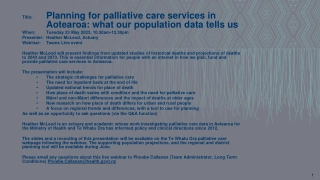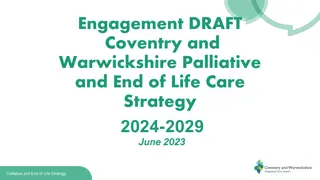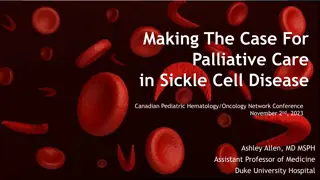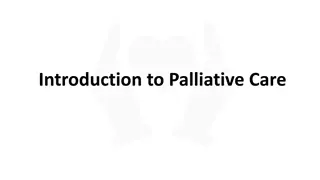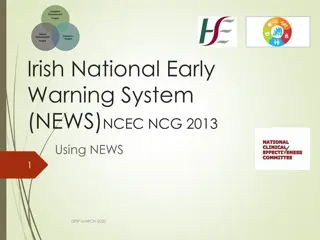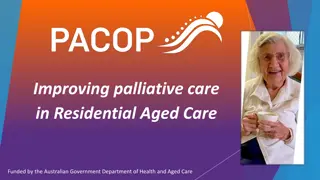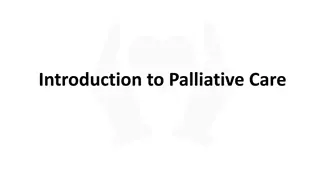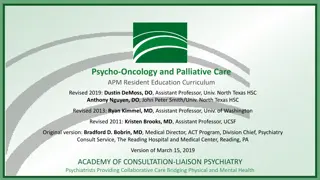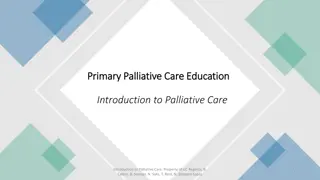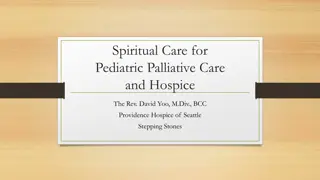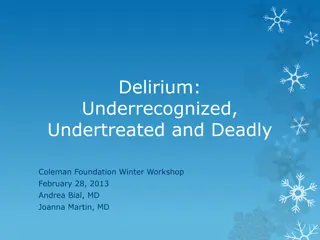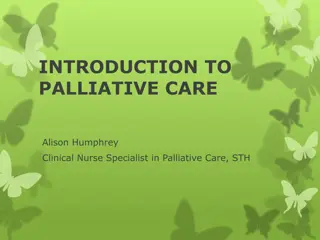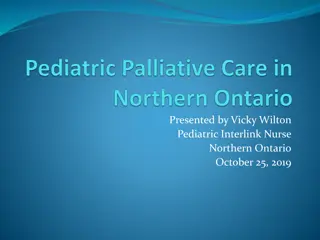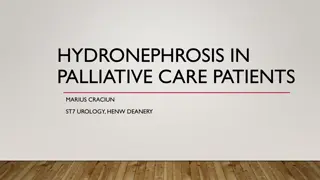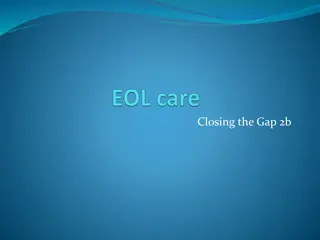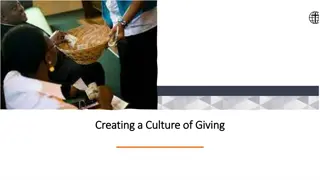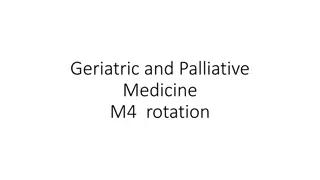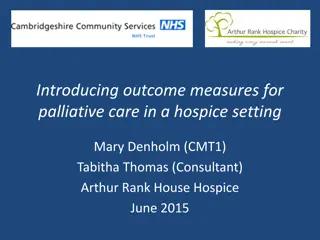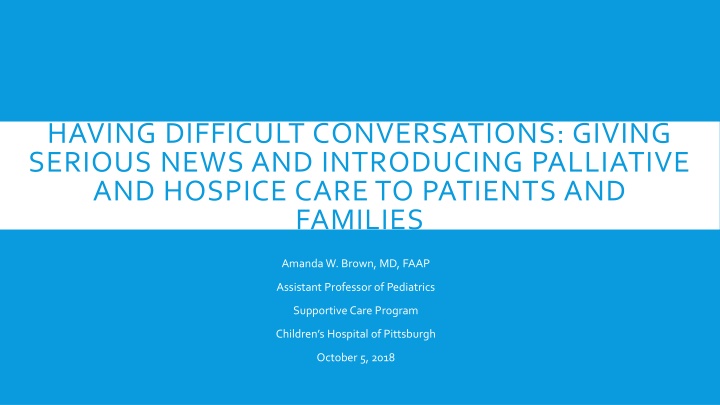
Having Difficult Conversations: Strategies for Giving Serious News in Healthcare
Learn about the Ask-Tell-Ask framework for delivering serious news, empathetic communication techniques, and introducing palliative and hospice care to patients and families. Understand the challenges and strategies involved in discussing serious news effectively in healthcare settings.
Download Presentation

Please find below an Image/Link to download the presentation.
The content on the website is provided AS IS for your information and personal use only. It may not be sold, licensed, or shared on other websites without obtaining consent from the author. If you encounter any issues during the download, it is possible that the publisher has removed the file from their server.
You are allowed to download the files provided on this website for personal or commercial use, subject to the condition that they are used lawfully. All files are the property of their respective owners.
The content on the website is provided AS IS for your information and personal use only. It may not be sold, licensed, or shared on other websites without obtaining consent from the author.
E N D
Presentation Transcript
HAVING DIFFICULT CONVERSATIONS: GIVING SERIOUS NEWS AND INTRODUCING PALLIATIVE AND HOSPICE CARE TO PATIENTS AND FAMILIES Amanda W. Brown, MD, FAAP Assistant Professor of Pediatrics Supportive Care Program Children s Hospital of Pittsburgh October 5, 2018
OBJECTIVES Describe the Ask-Tell-Ask framework for giving serious news Name at least two examples of empathic statements using the NURSE mnemonic Identify a strategy for introducing palliative and hospice care to patients and families
OUTLINE Background Giving the news: Ask-Tell-Ask Responding to the news: Expect emotion Talking to children about serious news Introducing our team
BACKGROUND Be brave enough to start a conversation that matters. -Margaret Wheatley
WHAT IS SERIOUS NEWS? Serious news is any information which seriously and adversely affects one s view of the future. (Buckman) results in a cognitive, behavioral, or emotionaldeficit that persists for some time (Ptaceket al.) Serious news vs bad news : does it matter? Examples? Buckman, How to break bad news: A guide for health care professionals , 1992 Ptacek JT, Eberhardt TL. Breaking bad news: a review of the literature. JAMA. 1996
WHAT WE KNOW ABOUT GIVING SERIOUS NEWS Giving serious news is hard Parents/families don t think we do it very well (Contro et al.) Recipients of serious news hear less than half of what is said (Kuttner) Physicians express discomfort having these conversations (McCabe et al.) We can get better at it with training and practice Contro N, Larson J, Scofield S, Sourkes B, Cohen H. Family Perspectives on the Quality of Pediatric Palliative Care. Arch Pediatr Adolesc Med. 2002 Kuttner, L. Talking with families when their children are dying. Medical Principles and Practice, 2007 McCabe M, Hunt E, Serwint J. Pediatric residents clinical and educational experiences with end-of-life care. Pediatrics, 2007;
WHY IS THIS SO HARD TO DO? Hard to know exactly what words to say (fear of saying the wrong thing) Fear of taking away a patient or family member s hope Time (distractions, etc.) Lack of formal education/training These are often emotion-laden conversations especially in pediatrics Prognostication can be challenging (hard to predict the future) Others?
GIVING THE NEWS: ASK- TELL-ASK The single biggest problem in communication is the illusion that it has taken place. -George Bernard Shaw
REMAP: A COMMUNICATION FRAMEWORK Reframe why the status quo isn t working. ASK- TELL- ASK Expect emotion and empathize. NURSE Map the future Align with the patient s values. Plan medical treatments that match patient values. Our focus today http://vitaltalk.org/guides/transitionsgoals-of- care/
GIVING THE NEWS:ASK-TELL-ASK ASK: What have the doctors been saying about .? What do you already know about what is happening ? Is now a good time to discuss .? What do you want to know about .? Some people like to know lots of details whereas other people want to know more about the big picture. What kind of person are you?
GIVING THE NEWS:ASK-TELL-ASK TELL Warning shot Headlines are succinct descriptions of the big picture Give the headline then stop!!! Avoid jargon If there is a lot of news to discuss, give in small pieces
GIVING THE NEWS: ASK-TELL-ASK Scenario #1: Rebecca is a 2 week old former FT infant who presented to the PICU with altered mental status and on further evaluation was found to be a victim of NAT. She is currently intubated and makes no spontaneous respiratory effort on the ventilator. Her neurologic exam reveals no evidence of purposeful movements and she is currently off of all sedation. Her brain imaging reveals significant injury consistent with hypoxic ischemic encephalopathy.
GIVING THE NEWS: ASK-TELL-ASK Scenario #1: Example Headline Rebecca has unfortunately suffered a significant brain injury to the thinking/feeling part of her brain. We are worried that she will not be able to talk, walk, eat, or breathe on her own. GIVE NEWS AND STOP TALKING
GIVING THE NEWS: ASK-TELL-ASK Scenario #2: Marcus is a 7 year old boy with a history of diffuse intrinsic pontine glioma which has progressed despite multiple rounds of therapy. He is currently admitted to the oncology service after he developed new neurologic deficits at home and unfortunately his repeat MRI now shows further progression of his disease.
GIVING THE NEWS:ASK-TELL-ASK Scenario #2: Example Headline Unfortunately, Marcus scan shows his tumor is growing. His cancer is getting worse despite the treatment.
GIVING THE NEWS: ASK-TELL-ASK Let s practice some of your own scenarios Take a few minutes to think of a recent case you have had where you have had to give serious news Think about what headline you would give and write it down
GIVING THE NEWS: ASK-TELL-ASK Clarify the patient s/family member s understanding Sometimes as doctors we don t explain things very well and I was wondering if you could tell me how you might tell your family members about what is going on so I make sure I explained it correctly. This is not always necessary but can be helpful to ensure on same page Invite questions: What questions do you have?
ASK TELL ASK VITAL Talk Video (ASK-TELL-ASK)
RESPONDING TO THE NEWS: EXPECT EMOTION AND EMPATHIZE At the end of the day people won t remember what you said or did, they will remember how you made them feel. -Maya Angelou
RESPONDING TO THE NEWS: EXPECT EMOTION AND EMPATHIZE After giving serious news, what is the typical patient response? Emotion (sadness, anger, etc.) Can be directed at the provider May be followed by a question or statement How can this be happening? Isn t there something you can do? You have to do something. You guys are supposed to be the experts! FM Radio: Emotional Data AM Radio: Cognitive Data
EMOTION AND COGNITION Vital Talk Video
EMOTIONS AS DATA Vital Talk Video
RESPONDING TO THE NEWS: EXPECT EMOTION AND EMPATHIZE After giving serious news, what is the typical provider response? Remember when they give you emotion, that means they heard the news so .. Take a deep breath Remember to STOP talking! Respond to the emotion using NURSE statements
NURSE STATEMENTS: EXPECT EMOTION AND EMPATHIZE Naming I can see this was really surprising news . It sounds like you are frustrated . Understanding I can t imagine how hard this must be for you. Respecting I can see how hard you have been advocating for your son. Supporting Our team is here to help you with this. Exploring Tell me more .
TALKING TO CHILDREN ABOUT SERIOUS NEWS The most important thing in communication is hearing what isn t said. -Peter Drucker
TALKING TO CHILDREN ABOUT SERIOUS NEWS Children as young as 3 years can be aware of a terminal prognosis even without an adult telling them. Avoidance can lead to: Feelings of abandonment Causes child to feel the need to protect the seemingly unknowing adult We must encourage and help parents talk about this difficult subject Levetown, M. Pediatrics. 2008
TALKING TO CHILDREN ABOUT SERIOUS NEWS Remember ASK-TELL-ASK? ASK: What do you understand about what is going on right now? TELL: Sometimes we don t have all the medications we need to make you better. I wish we did. ASK: What questions do you have for me? Can you say what we just talked about in your own words?
TALKING TO CHILDREN ABOUT SERIOUS NEWS Is talking about death harmful? Kreicbergs et al, NEJM 2004, Talking about death with children (N=429 Bereaved Parents) 1/3 talked, 2/3 did not talk No parents regretted talking Decisional regret more likely in parents who sensed (47%) vs. did not sense (13%) that their child was aware of his or her imminent death
TALKING TO CHILDREN ABOUT SERIOUS NEWS Will it cause patients and families to give up hope? Mack, et al. JCO. 2007 Universally parents want their physician to be honest while providing hope Parents are more likely to feel hopeful when they recalled detailed prognostic discussions Increased disclosure correlates with Increased trust Decreased emotional distress
TAKE HOME POINTS When giving serious news, remember the reframe and ASK-TELL-ASK ASK: For permission to talk about the news and what they understand so far TELL: Give the headline and give news in small chunks ASK: Encourage questions and ask for clarification After giving serious news, STOP!!!!! Remember your NURSE statements to help you respond to emotion
REFERENCES Buckman, R. How to Break Bad News: A Guide for Health Care Professionals. 223 pp. Baltimore, Johns Hopkins University Press, 1992 Ptacek JT, Eberhardt TL. Breaking bad news: A review of the literature. JAMA. 1996; 276 (6):496-502 Contro N, Larson J, Scofield S, Sourkes B, Cohen H. Family Perspectives on the Quality of Pediatric Palliative Care. Arch Pediatr Adolesc Med. 2002; 156:14-19 Kuttner, L. Talking with families when their children are dying. Medical Principles and Practice, 2007; 16:16-20 McCabe M, Hunt E, Serwint J. Pediatric residents clinical and educational experiences with end-of-life care. Pediatrics, 2007; 121: e731-737 Back A, Arnold R, Tulsky J. Mastering Communication with Seriously Ill patients: Balancing Honesty with Empathy and Hope. 158 pp. New York, Cambridge University Press, 2009 www.vitaltalk.org

